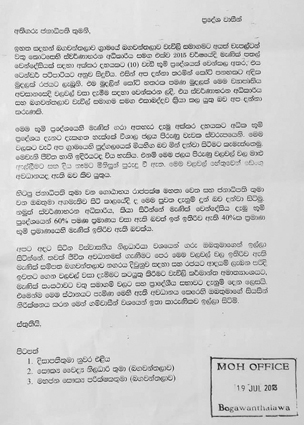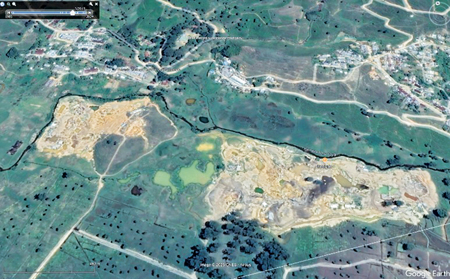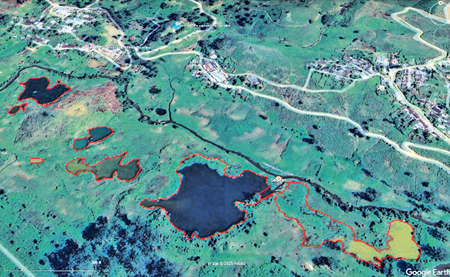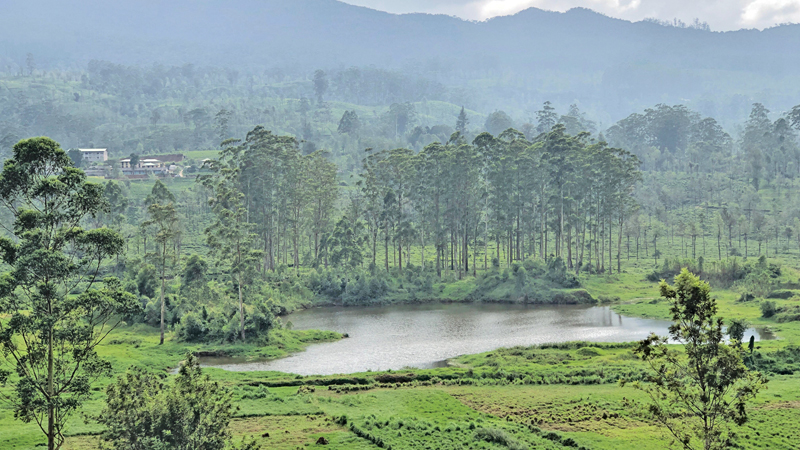 On August 16, 2016, 12-year-old Vigneswaran Mahisha had woken up in the middle of the night, screaming in terror from a nightmare. In her dream, she had seen her father, Marimuthu Vigneswaran, floating lifeless in a pit filled with water.
On August 16, 2016, 12-year-old Vigneswaran Mahisha had woken up in the middle of the night, screaming in terror from a nightmare. In her dream, she had seen her father, Marimuthu Vigneswaran, floating lifeless in a pit filled with water.
By this time, Vigneswaran had been missing for over 15 hours. On the day Vigneswaran disappeared, he had left their home in Theresia Estate, Bogawantalawa at 8:00 am to pick greens. But even by 5.00 p.m. he had not returned.
According to Vigneswaran’s wife, Siththan Kokilavarthani, a growing suspicion emerged that he might have gone to the abandoned gem mining area in the village. As night descended, the family’s anxiety only deepened.
Kokilavarthani recalled reassuring their frightened daughter, telling her that her father would be home by morning.
 By 5 am, with no word of Vigneswaran, a search party was formed, led by his brother. At Kokilavarthani’s insistence, he checked the abandoned gem mines, but found nothing in the dark. However, as daylight began to break, a horrifying sight awaited him. Vigneswaran, still clutching a bundle of greens in his hands, was found floating lifelessly in one of the pits.
By 5 am, with no word of Vigneswaran, a search party was formed, led by his brother. At Kokilavarthani’s insistence, he checked the abandoned gem mines, but found nothing in the dark. However, as daylight began to break, a horrifying sight awaited him. Vigneswaran, still clutching a bundle of greens in his hands, was found floating lifelessly in one of the pits.
“My daughter’s dream had come true in the most tragic way. The image of my husband floating in the water is still etched in my memory,” Kokilavarthani recalled.
“He was 45-years-old when he died. Given the suspicions surrounding his death, an investigation was carried out. It took us three long years to receive his death certificate. The Hatton Magistrate’s Court had ordered the police to seal off the gem pit where he died. Yet, despite the passing of nine years, the pit that claimed Vigneswaran’s life remains open to this day,” Kokilavarthani lamented.
Political promises and birth of a hazard
The opportunity for gem mining in the area was unlocked during the 2014 parliamentary election campaign when former President Ranil Wickremesinghe visited Bogawantalawa in Nuwara Eliya and pledged to issue permits for gem mining if he came to power. After the Good Governance Government was formed in 2015, he fulfilled that promise, enabling mining activities to begin in the region.
An agreement was reached between the Bogawantalawa Plantation Company and the National Gem and Jewellery Authority (NGJA), resulting in the allocation of lands in the Bogawantalawa – Chapelton Estate for gem mining. Alarmingly, these mining areas were situated dangerously close to the Theresia School and the estate workers dwellings. However Cabinet Paper No. 12/0007/527/001, approved on December 21, 2011, had officially designated these lands for gem mining, and large-scale excavations took place between 2016 and 2017.
The mining pits, situated near the Kehelgamu Oya, a tributary of the Mahaweli River were dug into grasslands that were traditionally used by estate workers for farming and cattle grazing.
Unclosed pits and deadly consequences
According to Google Earth Pro measurements, seven abandoned gem pits in Bogawantalawa span a total area of 39,333 square metres, which is equivalent to more than five football fields. These pits, left open after large-scale mining activities, continue to pose serious risks to the local community. Despite repeated warnings and requests from residents to the authorities, they remain unsealed, turning into dangerous water-filled depressions. Without immediate intervention, these pits not only remain a persistent hazard but could also contribute to further environmental damage and potential loss of life.
Satellite images from Google Earth Pro reveal that seven large pits, including two dug during the 2016 gem mining operations, remain unclosed, now appearing as massive water-filled ponds.

Satellite images from Google Earth Pro reveal that seven large pits, including two dug during the 2016 gem mining operations, remain unclosed
As per the agreement between the plantation company and the NGJA, it was the latters responsibility to close the pits after excavation. Documents obtained through the Right to Information Act from the Bogawantalawa Medical Officer of Health (MoH) by the reporter confirm that the failure to close these pits has led to serious hazards.
Local residents report that the large-scale gem mining activities has had a direct and significantly negative impact on estates such as Theresia, Bogawana, and Morar in Bogawantalawa while also indirectly affecting estates like Dunbar, Singarawatte, and Robgill. In 2016, during gem mining activities, deep pits were excavated, and it was observed by researchers that gem extraction was carried out not only through vertical shafts but also through horizontal tunnels.
This raised concerns among people living near the mining sites about the potential for land subsidence in the future. The extensive underground excavation combined with the open pits, increased fears that the stability of the land could be compromised, posing a long-term risk to both the environment and the local community.
In 2013, residents wrote to then-President Ranil Wickremesinghe, highlighting that the 10 acres of land allocated for gem mining had been abandoned and had since been filled with water. In the letter, obtained through an RTI request they warned that while one resident had already lost their life, many others remained at risk, as locals had begun using the water-filled pits for fishing and bathing. Despite repeatedly appealing to both former President Gotabaya Rajapaksa and Wickremesinghe to address the issue, no action had been taken. The residents urged Wickremesinghe to ensure the completion of mining activities and to instruct all relevant stakeholders to take immediate steps to close the pits. However, their pleas have gone unanswered.
MoH requests
Government bodies, including the Norwood Pradeshiya Sabha, the Ambagamuwa Divisional Secretariat, and the Nuwara Eliya District Secretariat, have repeatedly written to the National Gem and Jewellery Authority (NGJA) and the Bogawantalawa plantation company, urging them to close the hazardous pits. Despite multiple letters sent between 2018 and 2023, which clearly highlighted the dangers posed by these open pits, no action has been taken to address the issue to date. The local authorities have repeatedly warned that the open pits pose a significant risk of drowning, especially for children. The Medical Officer of Health’s (MOH) office has raised concerns that the stagnant water in these pits could serve as breeding grounds for mosquitoes, heightening the risk of dengue and other deadly diseases. In 2022, the NGJA sent a final letter to the plantation company, proposing a cost-free plan to extract any remaining gems from the pits while simultaneously closing them.
As per the original agreement, both the NGJA and the plantation company were responsible for restoring the mined land to its original grassy condition. The NGJA urged the plantation company to accept this proposal without delay, but no action to restore the area has been taken yet.
The Kandurata Gem Traders and Miners Welfare Association describes the gem mining project in Bogawantalawa’s Chapelton Estate as one of the largest gem excavation projects in South Asia.
Lives at risk
 “The mining period ended before operations were fully completed, and significant deposits of untouched gemstones remain in these pits. If the government were to auction these remaining deposits, it could generate substantial revenue. Exporting the extracted gems could bring in valuable foreign exchange,” a representative from the Association said. The association has reached out to Prime Minister Harini Amarasuriya and Central Province Governor Prof. Sarath Abayakoon regarding the matter.
“The mining period ended before operations were fully completed, and significant deposits of untouched gemstones remain in these pits. If the government were to auction these remaining deposits, it could generate substantial revenue. Exporting the extracted gems could bring in valuable foreign exchange,” a representative from the Association said. The association has reached out to Prime Minister Harini Amarasuriya and Central Province Governor Prof. Sarath Abayakoon regarding the matter.
Meanwhile, the National Gem and Jewellery Authority (NGJA) has claimed that the reason the pits remain open is due to the valuable gem deposits they contain, and that negotiations with the plantation company to resume mining operations have been ongoing since 2017.
Bogawantalawa Cattle Farmers’ Association President Palaniyandi Srikumar warned that the open pits present serious risks to both humans and animals. “We live in constant fear that we or our livestock may fall into these deep pits,” he said. Residents hold former Minister Palani Digambaram, who was in office when the mining took place, responsible for ensuring the pits are closed. “Since he was the Minister during the excavation period, he has a greater responsibility than anyone else to address this issue,” they said.
The abandoned mines are a constant reminder of Vigneswaran’s untimely death. According to Mahisha, her family faced significant financial hardships following her father’s demise. As a result, she had to abandon her dreams of studying at Uva Wellassa University.
“I was just 12 when my father passed away. There were so many gem pits in our area, all of them incredibly deep. No one in our village benefited from the mining. “The people who dug for gems made their money and left, but we are the ones who are suffering now,” she said. Even after nine years, the tragic death of Marimuthu Vigneswaran remains a painful reminder of the hazards posed by these abandoned pits. Unless immediate action is taken, more lives may be lost due to continued negligence and inaction.









